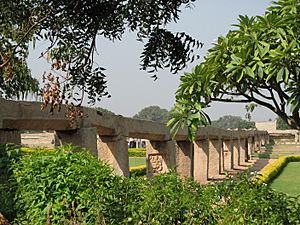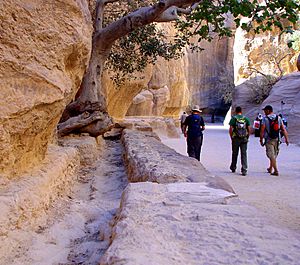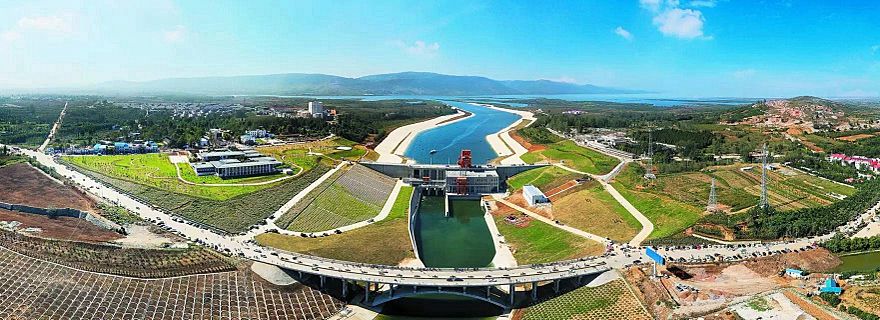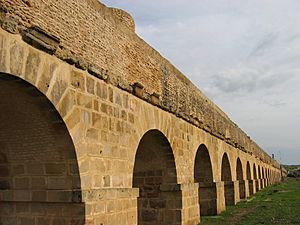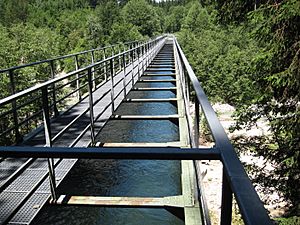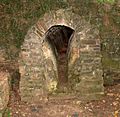Aqueduct facts for kids

An aqueduct is a special channel built by people to carry water from one place to another. They often bring water to cities and towns. Aqueducts can also carry water for irrigation (watering crops) or to make hydroelectricity (power from water). Pipes, canals, tunnels, and bridges that do this job are all called aqueducts. Some aqueducts are even big enough to carry a canal for boats and ships! The word "aqueduct" comes from two Latin words: "aqua" (meaning water) and "ducere" (meaning to lead). People have used aqueducts for thousands of years.
Contents
Aqueducts Through History
Even though we often think of the Romans when we hear "aqueduct," these clever water systems were actually invented much earlier. People in Greece, the Near East, and Indian subcontinent built them first. For example, the Egyptians and Harappans created amazing systems to water their farms. The Assyrians built a huge limestone aqueduct around 700 BC. It was 80 kilometers (50 miles) long and included a 10-meter (33-foot) high section to cross a valley. This brought water to their capital city, Nineveh.
Ancient Wonders
Aqueducts in India
Many people believe that some of the very first aqueducts were built in India. You can still see evidence of them at Hampi, Karnataka. Huge aqueducts near the Tungabhadra River once carried water for 15 miles (24 km) to water crops. These waterways also supplied water to royal bathtubs!
Aqueducts in Oman
In Oman, from the Iron Age, people built underground aqueducts called falaj or qanāts. These were like a series of vertical wells connected by gently sloping underground tunnels.
There are three main types of falaj:
- Daudi (داوودية): These use underground aqueducts.
- Ghaili (الغيلية): These need a dam to collect water.
- Aini (العينية): These get their water from a natural spring.
These systems allowed large farms to grow in a very dry land.
Aqueducts in Persia
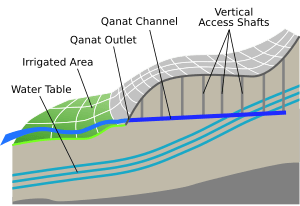
In Persia, people also built underground aqueducts called qanāts. These had many well-like shafts connected by gently sloping tunnels. This smart design allowed water to:
- Reach the surface from underground without needing pumps. Water flowed using gravity, as the destination was lower than the water source.
- Travel long distances in hot, dry places without losing much water to leaks or evaporation.
Aqueducts in Petra, Jordan
In Petra, Jordan, the Nabataean engineers were very clever. They used every natural spring and winter rainfall to move water where it was needed. They built aqueducts and pipe systems that carried water over mountains, through deep gorges, and into the temples, homes, and gardens of Petra. If you walk through the Siq, you can still see parts of the channels that brought water to the city. You can also see strong dams that stopped powerful floods.
Aqueducts in Greece
On the island of Samos, the Tunnel of Eupalinos was built around 538-522 BC. This was an underground aqueduct that brought fresh water to Pythagoreion. It worked for about a thousand years!
Roman Aqueducts

Roman aqueducts were built all over the Roman Empire, from Germany to Africa. The city of Rome itself had over 415 kilometers (258 miles) of aqueducts! These aqueducts brought fresh water to public baths and for drinking in large cities. Their engineering was so advanced that it wasn't matched for over a thousand years. The bridges with many arches, built from stone, are a famous part of Roman aqueducts. That's why the word "aqueduct" often makes us think of a bridge that carries water.
Aqueducts in South America
Near the Peruvian town of Nazca, an ancient system of aqueducts called Puquios was built. These are still used today! They were made of carefully placed stones, a common building material for the Nazca culture. Experts are still debating when they were built, but some think it was around 540-552 AD, to help with dry periods.
The Guayabo National Monument in Costa Rica has an amazing system of aqueducts. This complex network of open and covered aqueducts still works well. They are made from rounded river stones, mostly volcanic rock. We don't know much about the civilization that built them, but it's thought that Guayabo was a meeting point for ancient cultures like the Aztecs, Mayans, and Incas.
Aqueducts in North America
When Europeans first saw the Aztec capital Tenochtitlán in the early 1500s, the city got its water from two aqueducts. One of these, the Chapultepec Aqueduct, was built around 1420. The Spanish rebuilt it almost 300 years later. It used to cross part of Lake Texcoco, which is now gone. Only a small piece of it remains in Mexico City today.
Aqueducts in Sri Lanka
Ancient Sri Lanka used many detailed aqueducts. A great example is the Yoda Ela or Jaya Ganga. This water canal was 87 kilometers (54 miles) long. It carried extra water between two man-made reservoirs. It had a very gentle slope of only 10 to 20 centimeters per kilometer (about 4 to 8 inches per mile) in the fifth century AD. Sadly, the ancient engineering secrets for building such precise canals were lost when the civilization fell in the 13th century.
Modern Aqueducts Today
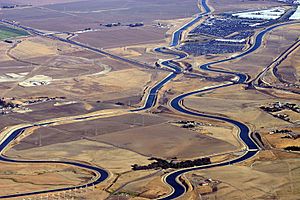
Today, aqueducts are a very important part of how many countries get their water.
The United States has some of the world's largest aqueducts. The Catskill Aqueduct brings water to New York City over 190 kilometers (120 miles). Even bigger are the aqueducts in the western part of the country. The Colorado River Aqueduct is 389 kilometers (242 miles) long. It supplies water to the Los Angeles area from the Colorado River. The California Aqueduct is even longer, at 701.5 kilometers (436 miles). It runs from the Sacramento-San Joaquin River Delta to Lake Perris. The Central Arizona Project is the biggest and most expensive aqueduct built in the United States. It stretches 336 miles (541 km) from near Parker, Arizona to the cities of Phoenix and Tucson.
In New Zealand, the "Oamaru Borough Race" aqueduct was built in the late 1800s. It carries water about 50 kilometers (31 miles) from the Waitaki River to the town of Oamaru.
Spain has the Tagus-Segura Water Transfer system, which opened in 1979. It moves water 286 kilometers (178 miles) from north to south.
In China, the South–North Water Transfer Project is a huge plan. It aims to connect the Yangtze River basin to Beijing using three different systems. Part of the project will reuse the old Grand Canal of China.
How Aqueducts are Built
Open Channels
The simplest aqueducts are just small ditches dug into the ground. Modern aqueducts can use much larger channels. For example, the Central Arizona Project uses channels that are 24 feet (7.3 meters) wide. A key part of designing any open channel is its slope, or gradient. A steeper slope allows a smaller channel to carry the same amount of water. However, a steeper slope also means the water can flow faster and potentially damage the aqueduct. A typical Roman aqueduct had a very gentle slope, about 1 unit of drop for every 4800 units of length.
Small Waterways (Rills)

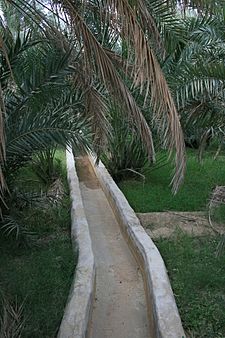
A rill is a small, built channel or aqueduct. It's usually made of stone, brick, concrete, or other strong materials. Rills are often straight and are used to carry water from a source like a river-creek, spring, reservoir, qanat, or larger aqueduct. This water can be used for homes or for agricultural irrigation of crop land.
Rills were traditionally used in the Middle East and Mediterranean climates in ancient times. They are different from a simple 'water ditch' because they are lined. This lining helps reduce water loss from soaking into the ground and makes them last longer. The Falaj irrigation system in the Al Ain Oasis in the Abu Dhabi Emirate uses rills as part of its qanat water system. In Spanish, they are sometimes called Acequias.
Rills are also used to make gardens look beautiful. They can be narrow channels of water built into garden paths, like long water features. They are often tiled and part of a fountain design. These ideas came from ancient Persian Gardens. Rills were later used a lot in the Moorish (Spanish) Gardens of Al-andalus, like the Alhambra in Granada.
Tunnels and Pipes
Aqueducts sometimes run underground through tunnels for part or all of their journey. A type common in North Africa and Central Asia, which has vertical wells at regular distances, is called a qanat. One old example in Syria, the Qanat Firaun, is over 100 kilometers (62 miles) long.
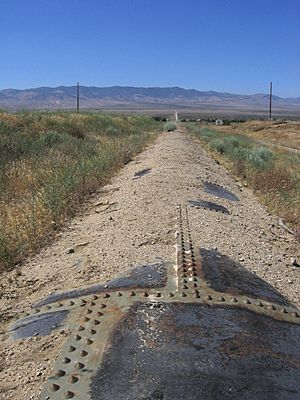
Modern aqueducts also use many pipelines. Pipelines are good for moving water long distances, especially over hills. They are also a better choice where open channels might lose water from evaporation, freezing, pollution, or harm the environment. Pipelines can also carry treated water that is safe to drink.
Why We Use Aqueducts
Historically, societies that farmed built aqueducts to irrigate their crops. Archimedes even invented the water screw to lift water for watering fields.
Another important use for aqueducts is to bring drinking water to large cities. They also help areas that don't get much rain by providing a water supply. Some of the Roman aqueducts still bring water to Rome today! In California, United States, three large aqueducts carry water hundreds of miles to the Los Angeles area. Two come from the Owens River area, and a third comes from the Colorado River.
Today, engineers study how water flows in open channels to design systems for flood control, irrigation, and large water supply projects. This is important when an aqueduct, rather than a pipeline, is the best solution.
In the past, aqueducts often had channels made of earth or other materials that let water soak through. This meant a lot of water was lost. As water becomes more precious, these canals are now being lined with concrete, polymers, or special soil that doesn't let water through. Sometimes, a new aqueduct is built next to an old one because the old one can't be shut down during construction.
Famous Aqueducts Around the World
Ancient Greek Aqueducts
Roman Aqueducts
- The Pont du Gard in southern France.
- Barbegal aqueduct, France.
- Eifel aqueduct, Germany.
- Caesarea Maritima, Israel.
- Kavala, Greece.
- Patras, Greece.
- Aqueduct of Segovia, Spain.
- Acueducto de los Milagros, Mérida, Spain.
- Tarragona, Spain.
- Almuñécar, Spain (5 aqueducts – 4 are still used).
- Valens aqueduct, Istanbul, Turkey.
- Aqua Augusta, Italy.
- Aqua Claudia and the Anio Novus, part of the Porta Maggiore, Rome, Italy.
- Skopje aqueduct, Skopje, Republic of Macedonia.
Other Aqueducts
- Wignacourt Aqueduct, Malta. Built in the 16th century to carry water from the old capital city of Malta, Mdina, to the new capital city Valletta. Today, you can still see parts of it in Balzan, Birkirkara, and Santa Venera.
- Aqueduct St-Clément, Montpellier, France – built in the 17th century.
- Águas Livres Aqueduct, in Lisbon, Portugal (built 1731-1748).
- Carioca aqueduct in Rio de Janeiro, Brazil (built 1744-1750).
- Aqueduct of Teruel, Spain.
- Roquefavour aqueduct, France – built between 1842 and 1847.
- Winnipeg aqueduct, Manitoba, Canada – built between 1915 and 1919.
- Canal de l'aqueduc, Quebec, Canada.
- Päijänne water Tunnel, a 120-kilometer (75-mile) long underground aqueduct (a continuous tunnel) connecting Lake Päijänne to Greater Helsinki.
- Wan Mat Saman aqueduct, Kedah, Malaysia – built between 1900 and 1909.
- Mathur aqueduct in Tamil Nadu state, India.
- Surviving Spanish aqueducts in Mexico:
- Aqueduct of Querétaro, Mexico – built between 1726 and 1738, 1.3 kilometers (0.8 miles) long with 74 arches.
- Aqueduct of Morelia, Michoacan, built between 1735 and 1738.
- Aqueduct of Acámbaro, Guanajuato, built in 1528.
- Levadas, 1350 miles (2170 km) of 17th-century aqueducts on the Portuguese island of Madeira.
- Espada aqueduct, built 1735, in San Antonio, Texas, United States.
- Quabbin aqueduct, 24.6 miles (39.6 km) long tunnel, in Massachusetts, United States.
- Chicopee Valley aqueduct, 13.1 miles (21.1 km) long, in Massachusetts, United States.
- Central Arizona Project Aqueduct.
- California aqueduct, a 714-mile (1149 km) long mix of canals, pipelines, and tunnels, in the Central Valley of the United States.
- Delaware aqueduct, in New York State, United States – at 85 miles (137 km) long, it's the world's longest continuous underground tunnel.
- High Bridge, part of the former Croton Aqueduct, built in 1848, is the oldest surviving bridge in New York City.
Images for kids
-
Galería de los Espejos (Gallery of Mirrors), a tunnelled part of a 25 km Roman aqueduct built during the 1st century AD near Albarracín (Spain)
-
The water conduit of the Tarragona Aqueduct, Spain.
-
The arches of an elevated section of the Roman provincial Aqueduct of Segovia, in modern Spain.
-
The ruins of the Aqua Marcia near Tivoli, built in 144–140 BC during the Roman Republic
-
Aqueduct near Belgrade in Ottoman Serbia, painted by Luigi Mayer
-
Rock-cut aqueduct feeding water to the mining site at Las Médulas
-
Map of the gold mine at Dolaucothi, showing its aqueducts
-
A portion of the Eifel Aqueduct, Germany, built in 80 AD. Its channel is narrowed by an accretion of calcium carbonate, accumulated through lack of maintenance.


